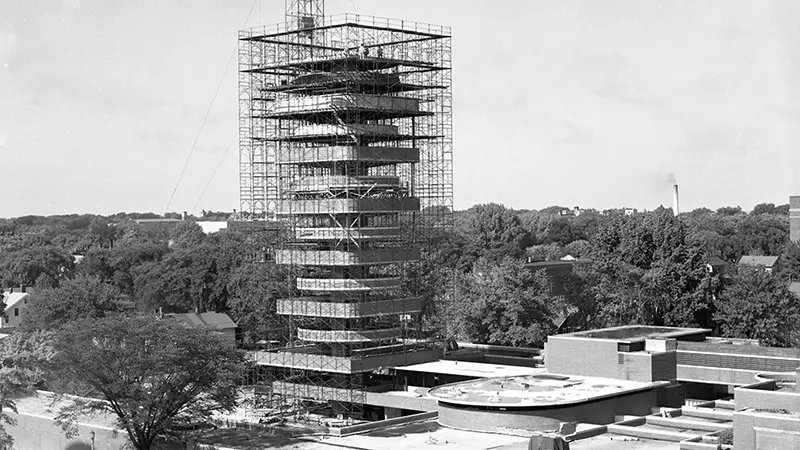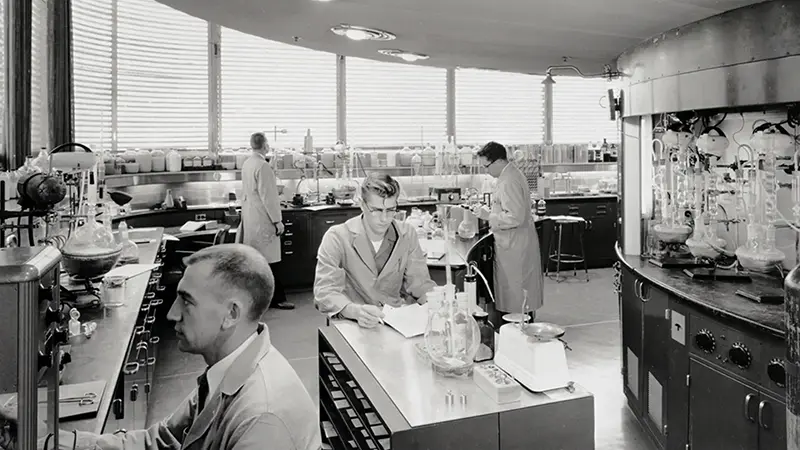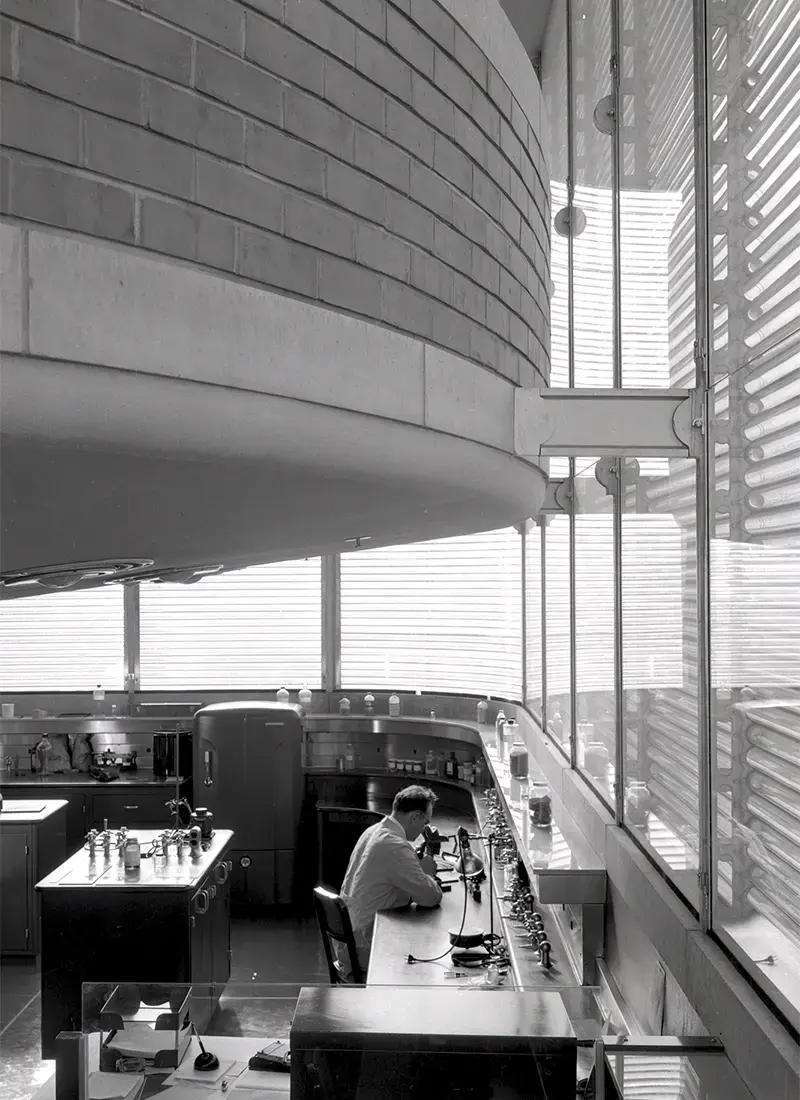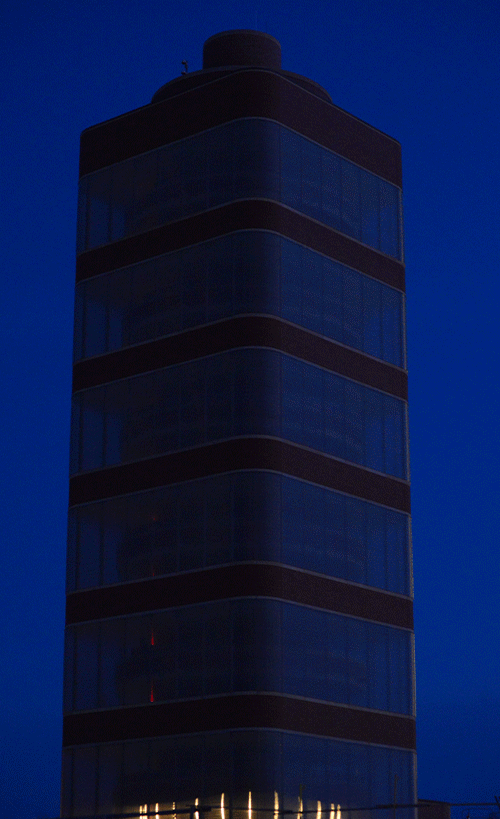In SC Johnson’s Frank Lloyd Wright-designed Research Tower, Architecture Meets Science
The SC Johnson Research Tower, which opened in 1950, is one of the tallest structures ever built on the cantilever principle. The inspiration for its form came from third-generation company leader H.F. Johnson, Jr., who had previously hired Frank Lloyd Wright to design the company’s renowned Administration Building. Contemplating how to make the new research facility unique, H.F. suggested Wright consider “going up in the air.”
What Wright did with that suggestion turned out to be remarkable.


"A Flower Among Weeds" in American Architecture
One of Frank Lloyd Wright's famous buildings, the tower rises more than 150 feet into the air and is 40 feet square. Yet at ground level, it’s supported by a base only 13 feet across at its narrowest point. As a result, the tower almost seems to hang in the air – a testament to creativity and an inspiration for the innovative products that would be developed inside.
Alternating square floors and round mezzanine levels make up the interior, and are supported by the “taproot” core, which also contains the building’s elevator, stairway and restrooms. The core extends 54 feet into the ground, providing stability like the roots of a tall tree.

Wright called his design a “helio-lab,” or sun-lighted laboratory. At the building’s dedication, he said he hoped it would be a “flower among the weeds” of typical, “drab” structures built for business.
SC Johnson Research Tower: A Home for Innovation
The Research Tower was the primary home of SC Johnson’s Research and Development efforts from 1950 to 1982, giving birth to trusted brands including Raid®, Glade®, OFF!® and Pledge®.
Was it the incredible design surrounding them that inspired these innovations? Or that a company culture that celebrated design was sure to be innovative itself?
We like to think it was both! And the tower, along with the Administration Building, became recognized as hallmarks of American design. Silhouettes of the buildings appeared on company letterhead, and even packaging, as enduring symbols of creative inspiration.

To ensure that the new labs would meet the many varied needs of the scientists and their work, extensive time was put into planning. Each pair of floors – the main floor and associated mezzanine – was painstakingly considered by laboratory management and personnel.
A full-size replica of a main floor and its mezzanine was erected in the parking lot outside the Administration Building, to facilitate in-person walk-throughs and discussions. Each floor was mocked up, one at a time, with laboratory equipment and materials. These mock ups were then studied, debated, rearranged and altered until a final layout could be confidently submitted to the equipment supplier for development and detailing.
The result was a state-of-the-art facility that would enable innovation and discovery for years to come. As one scientist recalled, “Sinks and water taps and power sources seemed to be everywhere. The availability of bench space, shelves, and bench storage space was unending, and there was empty contingency storage space for years.”

If one is in mind to build, the building should be a good one or none at all. We don’t build for today, but for tomorrow.H.F. Johnson
Jr. third-generation company leader
Company Architecture That's Still Alight with Promise
In 1982, new building codes required a fire escape be added to the exterior of the Research Tower if it was going to remain in use. After much consideration, we made the difficult decision to close the historic facility in order protect its sleek design. The tower also didn’t have the space for our continually growing R&D efforts.
Thirty-one years later, we launched an immense project to restore the building and reopen the first few levels to the public. We updated both the exterior and the interior of the structure, installing more energy-efficient features. We even cleaned the Pyrex tube windows (with our Windex® glass cleaner, of course).
In 2013, following a year of restoration, the Research Tower blinked alive once again, illuminating the night sky.

We continue to celebrate H.F.’s collaboration with Frank Lloyd Wright to this day, welcoming visitors from all over the globe to our free campus tours. Exhibits in the tower offer a look at the innovations that emerged from it and how the architecture stimulated the scientists’ creativity.
“My grandfather made incredibly bold decisions, one of which was to build these buildings in spite of the cost,” explained our Chairman and CEO, Fisk Johnson. “For me, they are a visual reminder of those decisions and of the importance of being bold when leading this enterprise.”
We hope you’ll visit to see the tower for yourself. Tours of our global headquarters and Frank Lloyd Wright-designed campus are free and open to the public with advance reservations. There truly is no more towering testament to innovation.
Visit SC Johnson:
Get an in-depth look at the only Frank Lloyd Wright-designed corporate headquarters that’s still in use.




